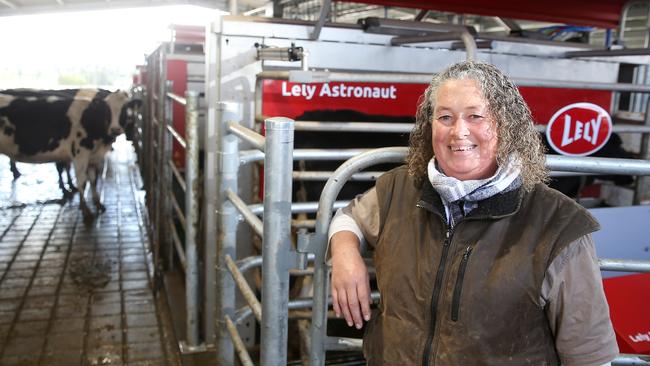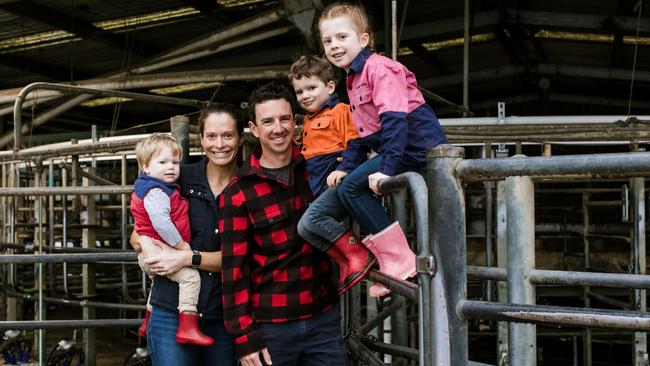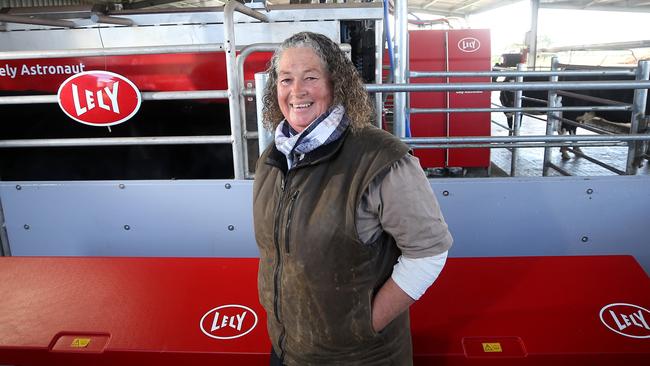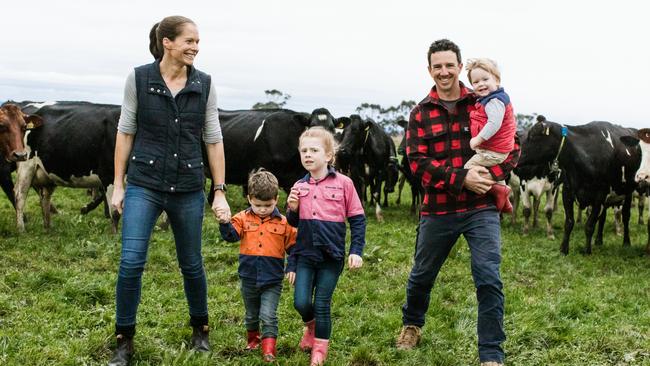Worker shortage hits dairy hard
The critical labour shortage is pushing dairy farmers to disperse their herds and sell up. See their stories here.
Dairying is not exempt from critical labour shortages affecting industries nationwide.
While many dairy farmers are offering increased wages, incentives and performance bonuses to retain and attract staff, others can’t find any applicants to offer incentives to.
The lack of staff has become dire for farmers such as Luke Randle at Newry, near Maffra, who milks 1050 cows. “I’ve never had less of a response than with the latest ad I put out (seeking staff),” Mr Randle said.
“To take the pressure off our full-time staff we have decided to milk less cows. We would’ve grown to an extra 200 cows but decided to sit stagnant. We can’t replace those full-time staff. We need to keep them so we are being extra cautious not to add too much to their workload.”
The Weekly Times understands farmers are dispersing their herds and selling up altogether due to the lack of staff, while others have looked at switching to beef as a less labour-intensive option.
Where there used to be a strong pool of relief milkers among backpackers, young school leavers or people wanting to work their way up in the industry, there isn’t anymore. The pool is dry.
The struggle to find farm labour and relief milkers led Rose and Glen Atherton to install a robotic dairy on their Drouin farm earlier this year.

The couple, who milk 400 Friesians on 300ha in West Gippsland, needed to update their old dairy and the odds stacked highly in favour of robots.
It was cost effective, met the labour shortage requirement, could be built within the same footprint of the old dairy while it was still in use, and would create more efficiencies with time management and production.
“We had an 18 swing-over herringbone and it was taking us over five hours in the spring to milk,” Rose said.
“The bottom line is we aren’t getting any younger. In the industry it’s getting harder and harder to find labour and people to come and milk. It’s for our future and a better lifestyle for our family.”
Maffra dairy farmers Brad and Jenna White have invested in automation across their dairy operation as well — not to replace workers, but to attract and retain them.

The Gippsland couple employ four staff, milking 500 cows on 162ha at Riverslea, in the Macalister Irrigation District.
They have completed some big upgrades over the past five years, from automating irrigation systems to recently installing automatic cup removers in their rotary dairy.
Brad said the innovations had freed up his workforce from repetitive tasks, boosted the team’s morale, increased productivity and made his operation more attractive for future staff.
“We can just get more jobs done outside the dairy than we were before, as far as general maintenance and other upgrades,” Brad said. “It has made life a whole lot easier.”
WIDESPREAD STAFF SHORTAGES
A third of dairy farmers reported that finding workers had been their biggest challenge, Dairy Australia’s May Situation and Outlook report showed.
Dairy Australia farm profit and capability general manager Greg Jarman said the report found labour availability, due to pandemic restrictions, was of increasing concern for dairy farmers with the industry hit by widespread workforce shortages in all regional areas. “Over recent years, dairy, like many agricultural industries, has found it increasingly challenging to recruit and retain staff to work on dairy farms,” Mr Jarman said.
“Also like many industries, since early 2019, followed by the impact of Covid-19 and the subsequent shortage of overseas workers has compounded the problem.”

The shortage means many family members are doing more, and longer, hours in businesses.
Farmers also reported that the inability to recruit was an impediment to growth. “The ongoing issue with labour supply has certainly placed constraints on business growth with one in five farmers (23 per cent) reporting they have reduced their herds in the last 12 months because of labour shortages,” Mr Jarman said.
Dairy Australia is launching a new marketing campaign to attract new people to the industry. It will be aimed at both traditional farm employees and workers from different backgrounds and industries.
“The dairy industry must remain focused on attracting people into dairy as an ongoing primary issue as we compete with all industries for talent,” Mr Jarman said.

ROBOTIC WORKFORCE
Installation of Rose and Glen Atherton’s robotic dairy began in January and the first cows were milked by robot last month.
“We’ve been able to adapt our herringbone and use the facilities we had there so we are still using the old dairy to dry off and treat cows,” Rose said.
“We didn’t have to do a whole new site. We expanded out into the yard and to the side about 5m. We already had the old milk vat and power room so all the services were there and we were still milking in the herringbone while we were transitioning.”
The Athertons chose a Lely robotic dairy because the Warragul service centre was local.
“The people we’ve bought it through we’ve been dealing with for 20 years. We know the service reputation we’ve had with them and that’s a key factor,” Rose said.
The technology has proven itself over the past decade and the Athertons also saw the benefits from installations on other local farms.
The installation process was straightforward but not without its difficulties.

“It was challenging at times but what isn’t when you are doing a big project like that,” Rose said.
“The cows are learning each time they come to the shed there is something different for them to take on board like navigating the sets of yards. They look at me and go, ‘where the hell do you want me to go today, Rose?’ It is all new and will take them time to learn.”
Rose said the most difficult part had been the change in mindset for her and Glen, having cows at the shed or in the paddock at different times and tweaks necessary to their management style.
“I have a new friend. It’s called Lely Alarms and it rings you if there is a problem and you get messages. We have had to adjust to it too and you have to change your mindset a little,” she said.
“So far it’s been fairly straightforward and simple. We’ve got a generator back up and if a robot shuts down you get an alarm so you can attend to it or you can get the service centre out. If I’ve had a problem they’ve been able to talk me through it. It’s a matter of gaining the knowledge of how to do these things.”
The Athertons calve year round and have been the sole supplier to micro dairy St David’s in Fitzroy for the past six years.
Milk production did drop initially when the robots were introduced but it has been rising steadily since. “We expected that. It’s a change to them and to us. Once the cows get used to the robots we expect the production to increase. That will take about three months,” Rose said.
The Athertons installed five robots but there are concrete and drainage provisions for six to allow for future herd increases. “The cows have converted really well to using it considering it is a big change,” Rose said.
Long-term, the Athertons expect the robots will save them money and time. Time that can be better spent doing other jobs on the farm or spent with their children.
“At the end of the day, if we updated the shed to a herringbone or a rotary, you still needed two people there and a rotary was going to cost more than the robots,” Rose said. “It came down to efficiency. We are looking forward to the future and to not have to spend as much time at the shed and be able to do other farm work and watch the kids play sport.”

AUTOMATION BOOSTS STAFF PRODUCTIVITY
Brad and Jenna White said using automation in their operation was about putting their staff’s skills to use in a more productive way.
“And it also gives the staff an interest as well,” Brad said.
“I’ve found with our guys they like the technology. They like seeing investment and improvements being made on the farm.”
Before the automatic cup removers, milking was a two-person job, with one person putting cups on, and a second taking cups off and spraying teats.
The automatic system makes the whole process more efficient, with just one person required to run milking.
“We’ve chosen to keep two people rostered on for each milking for safety and people not feeling like they are being left by themselves,” Brad said. “Once the cows are in and milking has started, the second person can go out and do other jobs and come back in for clean-up at the end.”
Installing the system was a big financial decision.
Brad and Jenna secured a $66,000 grant last year through the Woolworths Dairy Innovation fund, and contributed the same amount themselves to complete the job.
The fund was open to all dairy farmers in the Woolworths supply chain, including those supplying vendor brands such as Bega, which Brad and Jenna currently supply.
“I had found it hard to justify the cost not knowing how well it was going to work,” Brad said.
“When the grants popped up I thought why don’t we have a crack at trying to get this job done.
“As far as cost-benefit, we have seen a huge benefit to what it ended up costing us.”

Brad has been back on the family farm for the past 15 years, initially learning the ropes of managing grass, cows and optimising milk production under this father.
He and Jenna slowly took the reins, and now run the business themselves.
They have bought an additional property nearby, with an eye to either expand the herd or turn to beef production in the future.
Brad said his current focus was honing his business skills to run a profitable, resilient operation.
“I’ve done lots of people management, HR and business governance courses since taking on the business. That is all really interesting stuff,” he said.
“You never stop learning.
“We’ve got a bunch of local farmers together to run a business discussion group, which is solely focused on the business side of farming. It’s none of the day to day stuff; all about figures.
“If we can set ourselves up so that I can spend less time on day-to-day operations and more time following other interests and have people who are at the stage where they want to sink their teeth into cows and grass, and people who are passionate about it — that keeps everyone happy and moving forward.”




